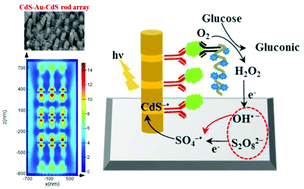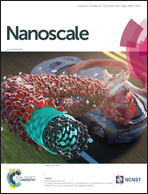Multi-segmented CdS–Au nanorods for electrochemiluminescence bioanalysis†
Abstract
In this study, we have developed a programmable electrochemiluminescence (ECL) system based on multi-segmented CdS–Au nanorod arrays with a sequential and highly tunable structure. The nanorod arrays were synthesized by an electrodeposition method using anodic aluminum oxide (AAO) as the template in which the Au and CdS segments were alternately electrodeposited. Compared to pure CdS nanorod arrays, multi-segmented CdS–Au nanorod arrays have showed a better ECL performance, which can be attributed to two factors: the favorable electron transfer and the surface plasma resonance (SPR) effect of the Au segment. On the one hand, we demonstrated that the Au segment can increase the charge transfer rate of CdS, which is beneficial for the ECL process because the generation of the radical state needs to accept electrons and then generate the radical state. On the other hand, the SPR of Au plasmon-induced local electromagnetic field enhancement can increase the radiative decay rate of CdS which makes the ECL process more efficient and lead to a higher ECL intensity. And also, an ECL sensor with multi-segmented CdS–Au nanorod arrays was constructed to detect prostate protein antigen (PSA). This study provides some basis for designing high-performance ECL emission materials and the construction of biosensors.



 Please wait while we load your content...
Please wait while we load your content...